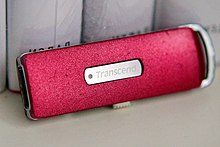



A flash drive (also thumb drive, memory stick, and pen drive/pendrive)[1][note 1] is a data storage device that includes flash memory with an integrated USB interface. A typical USB drive is removable, rewritable, and smaller than an optical disc, and usually weighs less than 30 g (1 oz). Since first offered for sale in late 2000, the storage capacities of USB drives range from 8 megabytes to 256 gigabytes (GB[note 2]), 512 GB and 1 terabyte (TB[note 3]).[4][5] As of 2023, 2 TB flash drives were the largest currently in production.[6][7] Some allow up to 100,000 write/erase cycles, depending on the exact type of memory chip used, and are thought to physically last between 10 and 100 years under normal circumstances (shelf storage time[note 4]).
Common uses of USB flash drives are for storage, supplementary back-ups, and transferring of computer files. Compared with floppy disks or CDs, they are smaller, faster, have significantly more capacity, and are more durable due to a lack of moving parts. Additionally, they are less vulnerable to electromagnetic interference than floppy disks, and are unharmed by surface scratches (unlike CDs). However, as with any flash storage, data loss from bit leaking due to prolonged lack of electrical power and the possibility of spontaneous controller failure due to poor manufacturing could make it unsuitable for long-term archiving of data. The ability to retain data is affected by the controller's firmware, internal data redundancy, and error correction algorithms.[8][9]
Until about 2005, most desktop and laptop computers were supplied with floppy disk drives in addition to USB ports, but floppy disk drives became obsolete after widespread adoption of USB ports and the larger USB drive capacity compared to the "1.44 megabyte" 3.5-inch floppy disk.
USB flash drives use the USB mass storage device class standard, supported natively by modern operating systems such as Windows, Linux, macOS and other Unix-like systems, as well as many BIOS boot ROMs. USB drives with USB 2.0 support can store more data and transfer faster than much larger optical disc drives like CD-RW or DVD-RW drives and can be read by many other systems such as the Xbox One, PlayStation 4, DVD players, automobile entertainment systems, and in a number of handheld devices such as smartphones and tablet computers, though the electronically similar SD card is better suited for those devices, due to their standardized form factor, which allows the card to be housed inside a device without protruding.
A flash drive consists of a small printed circuit board carrying the circuit elements and a USB connector, insulated electrically and protected inside a plastic, metal, or rubberized case, which can be carried in a pocket or on a key chain, for example. Some are equipped with an I/O indication LED that lights up or blinks upon access. The USB connector may be protected by a removable cap or by retracting into the body of the drive, although it is not likely to be damaged if unprotected. Most flash drives use a standard type-A USB connection allowing connection with a port on a personal computer, but drives for other interfaces also exist (e.g. micro-USB and USB-C ports). USB flash drives draw power from the computer via the USB connection. Some devices combine the functionality of a portable media player with USB flash storage; they require a battery only when used to play music on the go.
- ^ "thumb drive". Merriam-Webster. Archived from the original on December 7, 2021. Retrieved December 11, 2021.
- ^ "Jumpdrive". Merriam-Webster. Archived from the original on January 25, 2022. Retrieved December 11, 2021.
- ^ "Object of Interest: The Flash Drive". The New Yorker. Archived from the original on 2021-04-21. Retrieved 2018-10-04.
- ^ Madison, Alex (2016-07-09). "Keychain Not Included: The Five Highest-Capacity USB Flash Drives for Your Digital Life". Digital Trends. Archived from the original on 2016-10-19. Retrieved 17 October 2016.
- ^ Athow, Desire (2016-07-04). "The best USB flash drives 2016". Tech Radar. Archived from the original on 2016-10-16. Retrieved 17 October 2016.
- ^ Levin, Nancy (2023-01-19). "7 Largest Thumb Drives In The World". Largest.org. Retrieved 2023-10-26.
- ^ updated, Desire Athow last (2023-05-26). "Exclusive: This 2TB USB flash drive is the biggest ever, costs only $190 and delivers SSD-like performance". TechRadar. Retrieved 2023-10-26.
- ^ "USB Flash drive Resurrection". SecTechno. 29 May 2011. Archived from the original on 12 April 2022. Retrieved 12 December 2021.
- ^ "Understanding Life Expectancy of Flash Storage". www.ni.com. 2020-07-23. Archived from the original on 2020-12-19. Retrieved 2020-12-19.
Cite error: There are <ref group=note> tags on this page, but the references will not show without a {{reflist|group=note}} template (see the help page).